
Harvard Yard, in Cambridge, Massachusetts, is the oldest part of the Harvard University campus, its historic center and modern crossroads. It contains most of the freshman dormitories, Harvard's most important libraries, Memorial Church, several classroom and departmental buildings, and the offices of senior University officials including the President of Harvard University.

Harvard Square is a triangular plaza at the intersection of Massachusetts Avenue, Brattle Street and John F. Kennedy Street near the center of Cambridge, Massachusetts, United States. The term "Harvard Square" is also used to delineate the business district and Harvard University surrounding that intersection, which is the historic center of Cambridge. Adjacent to Harvard Yard, the historic heart of Harvard University, the Square functions as a commercial center for Harvard students, as well as residents of western Cambridge, the western and northern neighborhoods and the inner suburbs of Boston. The Square is served by Harvard station, a major MBTA Red Line subway and a bus transportation hub.

Massachusetts Hall is the oldest surviving building at Harvard College, the first institution of higher learning in the British colonies in America, and second oldest academic building in the United States after the Wren Building at the College of William & Mary. As such, it possesses great significance not only in the history of American education but also in the story of the developing English Colonies of the 18th century. Massachusetts Hall was designed by Harvard Presidents John Leverett and his successor Benjamin Wadsworth. It was erected between 1718 and 1720 in Harvard Yard. It was originally a dormitory containing 32 chambers and 64 small private studies for the 64 students it was designed to house. During the siege of Boston, 640 American soldiers took quarters in the hall. Much of the interior woodwork and hardware, including brass doorknobs, disappeared at this time.

The General Artemas Ward House is a historic house at 786 Main Street in Shrewsbury, Massachusetts. Commonly known as the "Artemas Ward House", it was the lifelong home of Artemas Ward, American Major General in the American Revolutionary War and a Congressman from Massachusetts. The house is listed on the National Register of Historic Places.

The Reginald A. Daly House is a historic house located in Cambridge, Massachusetts. It is a National Historic Landmark, notable for its association with Reginald Aldworth Daly (1871–1957), an eminent geologist, Penrose Medal winner, and Harvard University professor.
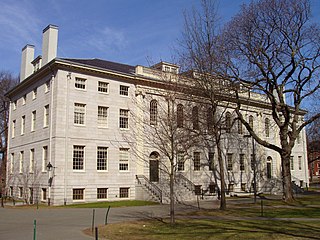
University Hall is a white granite building designed by the great early American architect Charles Bulfinch and built by the noted early engineer Loammi Baldwin, Jr. It is located in Harvard Yard on the campus of Harvard University in Cambridge, Massachusetts. It was designated a National Historic Landmark in 1970 for its architectural significance.
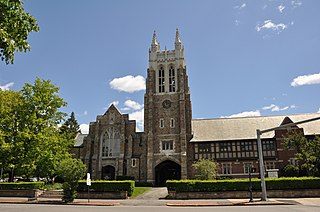
The First Unitarian Universalist Society in Newton occupies a prominent location at 1326 Washington Street in the heart of the village of West Newton in Newton, Massachusetts. Architect Ralph Adams Cram designed the church, Frederick Law Olmsted Jr. designed the grounds, the cornerstone was laid in 1905, and it was dedicated in 1906; it is one of the village's oldest buildings. The church is in Cram's signature Gothic Revival style, with buttressed walls and a blocky square tower with crenellations and spires. An enclosed courtyard is formed by an office wing, banquet hall, and parish house, which are built to resemble Elizabethan architecture with brick first floor and half-timbered upper level.

Grace Hopkinson Eliot Hall, often called Eliot Hall, is a historic dormitory building on the Radcliffe Quadrangle of Harvard University in Cambridge, Massachusetts. The four story neo-Georgian brick building was built in 1907 to a design by Alexander Wadsworth Longfellow Jr. It is a duplicate of Bertram Hall, which is adjacent, except some of its architectural details were simplified to reduce costs. The house is named in honor of Grace Hopkinson Eliot, the wife of Harvard President Charles W. Eliot. The building is now one of the dormitories of Cabot House.
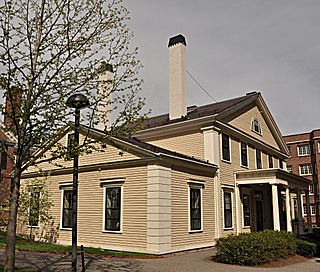
The Beck-Warren House, also known as the Warren House, is a historic house located in Cambridge, Massachusetts. Now on the campus of Harvard University, this large Greek Revival wood-frame house was built in 1833 for Professor Charles Beck, and was later purchased and adapted by the physically disabled Henry Clarke Warren, a Sanskrit scholar. Since 1899 it has belonged to Harvard University, for whom it presently houses offices. The house was listed on the National Register of Historic Places in 1996.

Bertram Hall at Radcliffe College is an historic dormitory building on the Radcliffe Quadrangle of Harvard University at 53 Shepard Street in Cambridge, Massachusetts. Built in 1901, it was the first dormitory building constructed for Radcliffe College. The building is now one of the dormitories of Harvard's Cabot House. It was listed on the National Register of Historic Places in 1986.

The William F. Bradbury House is an historic house at 369 Harvard Street in Cambridge, Massachusetts. The three-story brick Second Empire house was built in 1877 by William F. Bradbury, head master of the Cambridge Latin School. The pressed brick construction was rare for Cambridge at the time, and the house is now one of the few single family houses of the period to remain on Harvard Street, which was once lined by single-family houses.

The E. E. Cummings House is an historic house at 104 Irving Street in Cambridge, Massachusetts. The house was the childhood home of author and poet E. E. Cummings. The Colonial Revival house was built in 1893 for Cummings' parents, and was listed on the National Register of Historic Places in 1983.

The Dana-Palmer House is an historic house in Cambridge, Massachusetts. The two-story wood-frame house was built in 1823, and is basically Federal in its styling, although it has a Greek Revival porch. The house was built on land belonging to the Dana family, and was occupied by Richard Henry Dana Sr. among others, before its acquisition by Harvard University in 1835. From 1839 to 1843 the building was used as Harvard's first astronomical observatory, before being converted for use as a residence for William Cranch Bond, the observatory's director. One of its residents of long tenure was George Herbert Palmer, who lived there for nearly forty years; others include Andrew Preston Peabody and William James. In 1947 the house was moved from the site where Lamont Library currently sits to its present location across Quincy Street, and alterations made for its astronomical uses were reversed.

The Jarvis is a historic apartment building at 27 Everett Street, on the north side of the Harvard University campus in Cambridge, Massachusetts. Built in 1890, the 4+1⁄2-story brick building was one of the first apartment houses built in the vicinity of northern Massachusetts Avenue. At the time, Massachusetts Avenue north of Harvard was predominantly lined with large fashionable houses. The Jarvis fit into this to some extent by being designed to resemble a large single family residence of the time. The building has irregular Queen Anne massing, polychrome trim, and massive corbelled end chimneys.
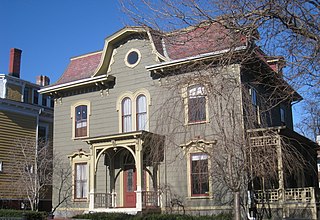
The William R. Jones House is an historic house at 307 Harvard Street in Cambridge, Massachusetts. It is a 2+1⁄2-story wood-frame house, whose Second Empire styling includes a flared mansard roof and flushboarded siding scored to resemble ashlar stone. It has a rare example in Cambridge of a curvilinear front gable, in which is an oculus window. Its windows are topped by heavy decorative hoods, and the porch features square posts with large decorative brackets. The house was built c. 1865 for William R. Jones, a soap manufacturer, and typifies the houses that were built lining Harvard Street in the 19th century after the Dana estate was subdivided.

The Joseph Lovering House is an historic house located at 38 Kirkland Street in Cambridge, Massachusetts.

Ware Hall is an historic residential apartment building at 383 Harvard Street in Cambridge, Massachusetts. It was designed by local architect George Fogerty and built in 1893. Fogerty was also the architect of Claverly Hall, a similar building, on Mount Auburn Street. This five story brick Classical Revival building is a rare example of an apartment house built in Mid Cambridge that was designed to cater to Harvard University students. Apartment blocks of this quality were generally built closer to the Harvard campus, so this one stands out when compared to other apartment house in its immediate surroundings.

The University Museum is a historic building that houses several museums belonging to Harvard University. The building is located at 24-28 Oxford Street and 11-25 Divinity Avenue in Cambridge, Massachusetts. It houses both the Harvard Museum of Natural History at 26 Oxford Street, and the Peabody Museum of Archaeology and Ethnology at 11 Divinity Avenue, as well as several departments of Harvard's Museum of Comparative Zoology and the Mineralogical & Geological Museum.
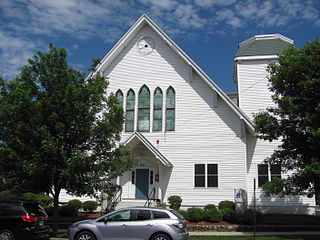
The First Unitarian Church is a historic former church building in Stoneham, Massachusetts. One of Stoneham's more stylish Gothic Revival buildings, the Stick style wood structure was built in 1869 for a Unitarian congregation that was organized in 1858. The building was listed on the National Register of Historic Places in 1984, and included in the Central Square Historic District in 1990. It presently houses the local Community Access Television organization.

Pittsfield Universalist Church is a historic church at 112 Easy Streets in Pittsfield, Maine. Built in 1898–99 with parts dating to 1857, it is one of the town's finest examples of Queen Anne architecture and is noted for its artwork and stained glass. The building was listed on the National Register of Historic Places in 1983.























